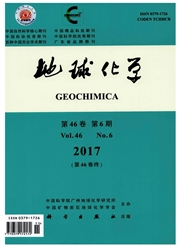

 中文摘要:
中文摘要:
东北地区中生代火成岩的Sr-Nd同位素填图显示该区可划分为4个Sr-Nd同位素省:大兴安岭北区同位素省(Ⅰ)、大兴安岭南区(Ⅱ-)-辽源-延吉(Ⅱ2)同位素省、张广才岭-佳木斯同位素省(Ⅲ)及完达山外来地体(Ⅳ)。在南兴安岭的林西.霍林河地区存在一条近似平行索伦-贺根山-小兴安岭古缝合带的高swa(t)早白垩世中酸性火成岩带,该带很可能为南北大兴安岭的岩石圈边界。在西乌珠穆沁旗一带出露具低εNd(t)(-10.5--6.3)、高TDM(1.22~1.51Ga)和中等放射成因Sr(^87Sr/^86Sr(i)=0.7063—0.7066)的安山岩,可能反映区域上存在古老的岩石圈或微古陆块。张广才岭.佳木斯地区中生代花岗岩的εNd(t)为-3.5-+2.1、TDM=1.0—1.27Ga和^87Sr/^86Sr(i)=0.705~0.711,反映了古亚洲洋远洋沉积物或变沉积岩为区域地壳的重要组分之一。完达山地体出露了中国东部唯一的中生代HIMU型洋岛玄武岩,为拼贴增生的外来地体。Sr-Nd同位素填图结果反映东北地区地壳增生作用主要发生在中侏罗世前,局部的地壳增生作用可能一直持续到早白垩世,主要出现在活动深大断裂带或古缝合带区域。
 英文摘要:
英文摘要:
New Sr-Nd that the region can be isotope mapping results of the Mesozoic igneous rocks from the northeastern China indicate subdivided into four Nd isotope provinces: the northern Da Hinggan Mountains area (Ⅰ),the southern Da Hinggan Mountains ( Ⅱ1)-Liaoyuan-Yanji (Ⅱ2) region, the Zhangguangcailing-Jiamusi block (Ⅲ) and the Wandashan massif (Ⅳ). In the southern Hinggan Mountains region, from Linxi to Holinhe distributes an early Cretaceous felsic igneous belt characterized by highly positive εNd(t) and low TDM. This felsic igneous belt is subparallel to the Solon-Hegenshan-Xiao Hinggan Mountains suture and may represent the lithospheric boundary between the northern and southern Da Hinggan Mountains regions. At Xi Ujimqin Qi, the Mesozoic andesites show highly nonradiogenic Nd ( εNd(t) -- -- 10. 5 --6. 3 and TDM = 1.22 - 1.51 Ga) and moderately radiogenic Sr (^87Sr/^86Sr(i) = 0. 7063 - 0. 7066) paleo-micromassif. The Mesozoic relatively nonradiogenic Nd ( εNd(t) isotope compositions, granitoids from the indicative of the existence of ancient lithosphere or Zhangguangcailing =-3.5- +2.1, TDM=1.0-1.27Ga) -Jiamusi block are characterized by and highly radiogenic Sr (^87Sr/^86Sr(i) =0. 705- 0. 711) isotope compositions. Such features reflect an important contribution of pelagic sediments or their metamorphosed derivates in the crust. A remarkable characteristic of the Wandashan massif is the occurrence of Mesozoic high-μ type oceanic island basalt (HIMU-OIB) that has never been reported in the eastern China.Combined with the regional strata that show clear difference from other terrains, the HIMU-OIBs and their related ultramafic-mafic complexes are probably relicts of a foreign terrain that was overthrust to the NE Asian continental margin during Mesozoic time. Our new Sr-Nd isotope mapping results also suggest that the main episodes of crustal growth in NE China had occurred by the end of Middle Jurassic (ca. 160 Ma), and probably p
 同期刊论文项目
同期刊论文项目
 同项目期刊论文
同项目期刊论文
 期刊信息
期刊信息
